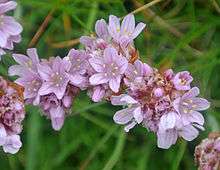Armeria maritima
| Armeria maritima | |
|---|---|
 | |
| Armeria maritima at Dunnet Head, Scotland | |
| Scientific classification | |
| Kingdom: | Plantae |
| Clade: | Angiosperms |
| Clade: | Eudicots |
| Order: | Caryophyllales |
| Family: | Plumbaginaceae |
| Genus: | Armeria |
| Species: | A. maritima |
| Binomial name | |
| Armeria maritima | |
| Synonyms[1] | |
| |
Armeria maritima, commonly known as thrift, sea thrift or sea pink, is a species of flowering plant in the family Plumbaginaceae. It is a compact perennial which grows in low clumps and sends up long stems that support globes of bright pink flowers. In some cases purple, white or red flowers also occur. It is a popular garden flower and has been distributed worldwide as a garden and cut flower. It does well in gardens designed as xeriscapes or rock gardens.
Armeria maritima sensu lato has a circumpolar distribution can be found in the wild in coastal areas across the Northern Hemisphere[2] but also occurs in parts of South America. It can grow in dry, sandy, saline conditions such as coastal cliffs, grassland and salt marshes, salted roadsides and inland on mountain rocks.[3]:434[4]:70 It is a common sight in British salt marshes.

Armeria maritima has a great copper-tolerance, and is able to grow in soils with copper concentrations of up to 6400 mg/kg. One mechanism proposed is that not much copper is transported up the shoot of the plant, and is excreted from decaying leaves.[5] Some of the physiology and metabolism of this species has been described, of particular note is how the metabolism of this species is altered with elevated atmospheric carbon dioxide concentrations.[6]
There are several subspecies. In England, subspecies elongata (Tall Thrift) is designated as a species of principal importance for biodiversity conservation under the NERC Act (2006).
The British threepence coin issued between 1937 and 1952 had a design of thrift on the reverse.
As part of a 2002 marketing campaign, the plant conservation charity Plantlife chose sea thrift as the "county flower" of the Isles of Scilly.
References
- ↑ The Plant List: A Working List of All Plant Species, retrieved 11 May 2016
- ↑ Anderberg, Arne. "Den Virtuella Floran: Trift, Armeria maritima Willd". Naturhistoriska riksmuseet, Stockholm. Retrieved 17 February 2017.
- ↑ Stace, C. A. (2010). New Flora of the British Isles (Third ed.). Cambridge, U.K.: Cambridge University Press. ISBN 9780521707725.
- ↑ Blamey, M.; Fitter, R.; Fitter, A (2003). Wild flowers of Britain and Ireland: The Complete Guide to the British and Irish Flora. London: A & C Black. ISBN 978-1408179505.
- ↑ Brewin LE, Mehra A, Lynch PT, Farago ME (March 2003). "Mechanisms of copper tolerance by Armeria maritima in Dolfrwyong Bog, north Wales—initial studies" (PDF). Environ Geochem Health. 25 (1): 147–56. PMID 12901090.
- ↑ Davey, M. P.; Harmens, H.; Ashenden, T. W.; Edwards, R.; Baxter, R. (2007). "Species-specific effects of elevated CO2 on resource allocation in Plantago maritima and Armeria maritima". Biochemical Systematics and Ecology. 35 (3): 121. doi:10.1016/j.bse.2006.09.004.
External links
| Wikimedia Commons has media related to Armeria maritima. |